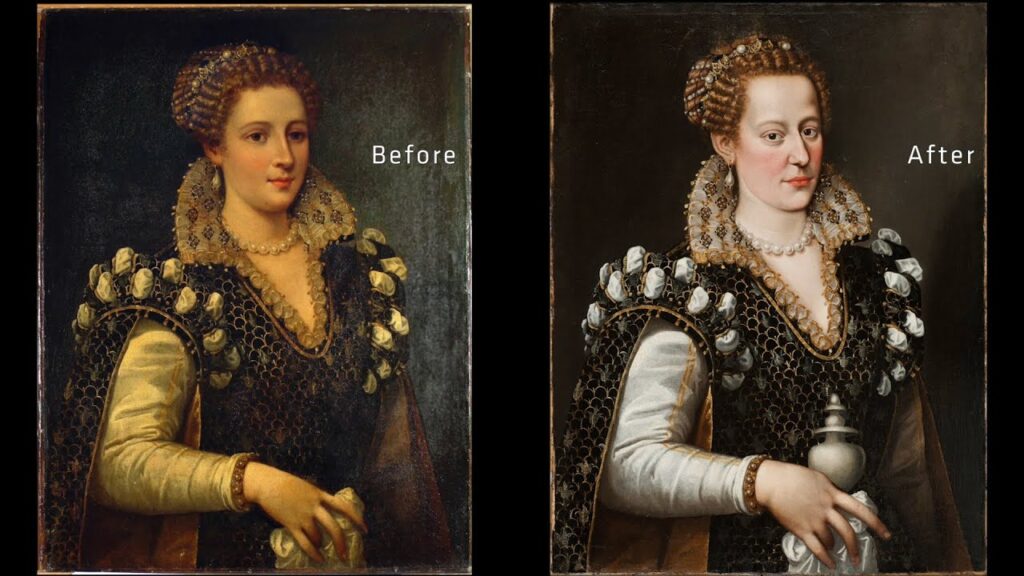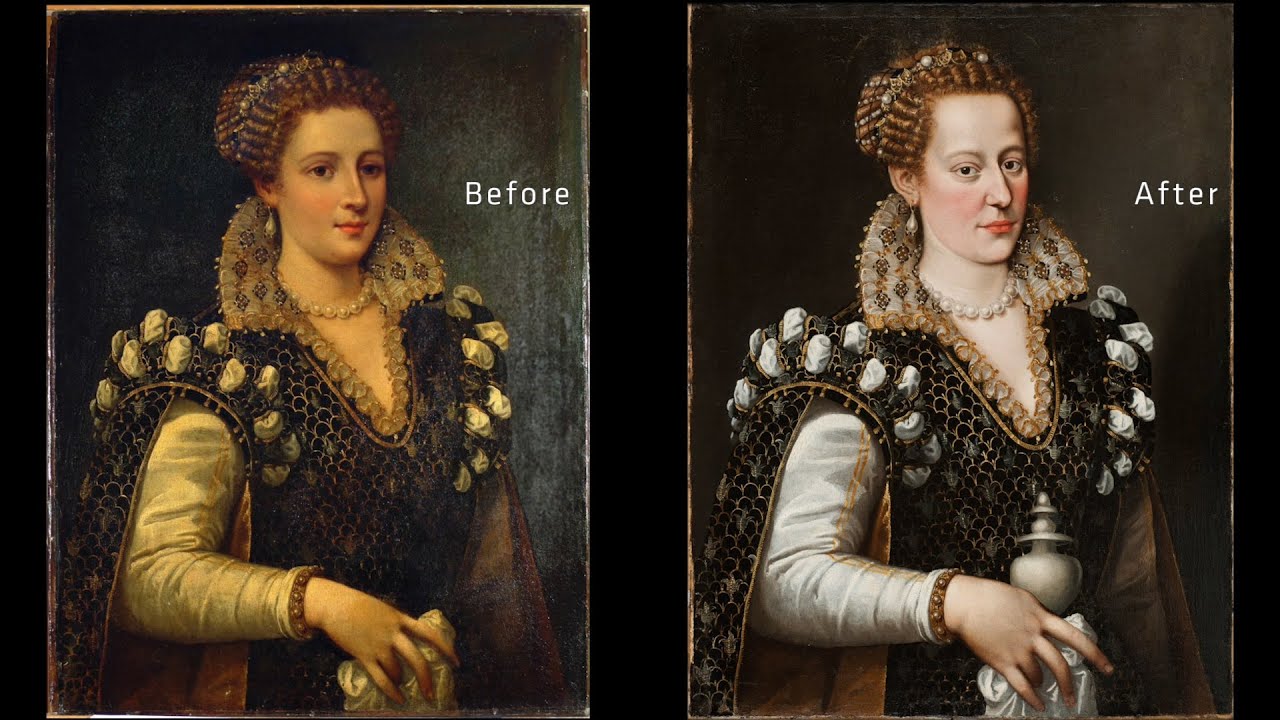A Determined Art Conservator Restores a Painting of the Doomed Party Girl Isabella de’ Medici: See the Before and After

Some people talk to plants.
The Carnegie Museum of Art‘s chief conservator Ellen Baxter talks to the paintings she’s restoring.
“You have to …tell her she’s going to look lovely,” she says, above, spreading varnish over a 16th-century portrait of Isabella de’ Medici prior to starting the laborious process of restoring years of wear and tear by inpainting with tiny brushes, aided with pipettes of varnish and solvent.
Isabella had been waiting a long time for such tender attention, concealed beneath a 19th-century overpainting depicting a daintier featured woman reputed to be Eleanor of Toledo, wife of Cosimo I de’ Medici, the second Duke of Florence.
Louise Lippincott, the CMA’s former curator of fine arts, ran across the work in the museum’s basement storage. Record named the artist as Bronzino, court painter to Cosimo I, but Lippincott, who thought the painting “awful”, brought it to Ellen Baxter for a second opinion.
As Cristina Rouvalis writes in Carnegie Magazine, Baxter is a “rare mix of left- and right-brained talent”, a painter with a bachelor’s degree in art history, minors in chemistry and physics, and a master’s degree in art conservation:
(She) looks at paintings differently than other people, too—not as flat, static objects, but as three-dimensional compositions layered like lasagna.
The minute she saw the oil painting purported to be of Eleanor of Toledo… Baxter knew something wasn’t quite right. The face was too blandly pretty, “like a Victorian cookie tin box lid,” she says. Upon examining the back of the painting, she identified—thanks to a trusty Google search—the stamp of Francis Leedham, who worked at the National Portrait Gallery in London in the mid-1800s as a “reliner,” transferring paintings from a wood panel to canvas mount. The painstaking process involves scraping and sanding away the panel from back to front and then gluing the painted surface layer to a new canvas.
An X-Ray confirmed her hunch, revealing extra layers of paint in this “lasagna”.
Careful stripping of dirty varnish and Victorian paint in the areas of the portrait’s face and hands began to reveal the much stronger features of the woman who posed for the artist. (The Carnegie is banking on Bronzino’s student, Alessandro Allori, or someone in his circle.)

Lippincott was also busily sleuthing, finding a Medici-commissioned copy of the painting in Vienna that matched the dress and hair exactly. Thusly did she learn that the subject was Eleanor of Toledo’s daughter, Isabella de’ Medici, the apple of her father’s eye and a notorious, ultimately ill-fated party girl.
The History Blog paints an irresistible portrait of this maverick princess:
Cosimo gave her an exceptional amount of freedom for a noblewoman of her time. She ran her own household, and after Eleanor’s death in 1562, Isabella ran her father’s too. She threw famously raucous parties and spent lavishly. Her father always covered her debts and protected her from scrutiny even as rumors of her lovers and excesses that would have doomed other society women spread far and wide. Her favorite lover was said to be Troilo Orsini, her husband Paolo’s cousin.
Things went downhill fast for Isabella after her father’s death in 1574. Her brother Francesco was now the Grand Duke, and he had no interest in indulging his sister’s peccadilloes. We don’t know what happened exactly, but in 1576 Isabella died at the Medici Villa of Cerreto Guidi near Empoli. The official story released by Francesco was that his 34-year-old sister dropped dead suddenly while washing her hair. The unofficial story is that she was strangled by her husband out of revenge for her adultery and/or to clear the way for him to marry his own mistress Vittoria Accoramboni.
Baxter noted that the urn Isabella holds was not part of the painting to begin with, though neither was it one of Leedham’s revisions. Its resemblance to the urn that Mary Magdalene is often depicted using as she annoints Jesus’ feet led her and Lippincott to speculate that it was added at Isabella’s request, in an attempt to redeem her image.
“This is literally the bad girl seeing the light,” Lippincott told Rouvalis.
Despite her fondness for the subject of the liberated painting, and her considerable skill as an artist, Baxter resisted the temptation to embellish beyond what she found:
I’m not the artist. I’m the conservator. It’s my job to repair damages and losses, to not put myself in the painting.
Related Content
The Art of Restoring a 400-Year-Old Painting: A Five-Minute Primer
Watch a 17th-Century Portrait Magically Get Restored to Its Brilliant Original Colors
A Restored Vermeer Painting Reveals a Portrait of a Cupid Hidden for Over 350 Years
How an Art Conservator Completely Restores a Damaged Painting: A Short, Meditative Documentary
Free Course: An Introduction to the Art of the Italian Renaissance
– Ayun Halliday is the Chief Primatologist of the East Village Inky zine and author, most recently, of Creative, Not Famous: The Small Potato Manifesto and Creative, Not Famous Activity Book. Follow her @AyunHalliday.


